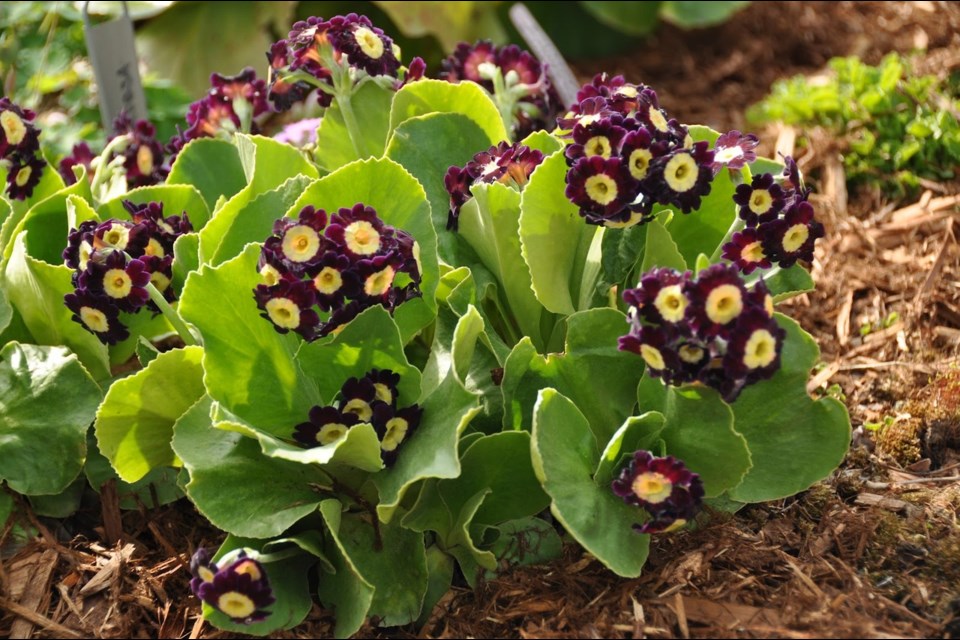If you want early spring bloom and you garden in the shade, three species of primroses (Primula) and five species of Solomon’s seal (Polygonatum) have proven rock hardy on the Canadian prairies. Try them!
Primroses (Primula spp.)
It’s hard to imagine a prairie spring without primrose. There are over 400 species but only a handful flourish in our northern gardens. The genus name is from the Latin primus, meaning first, referring to its early spring flowers. All primroses do best in shade in evenly moist but well-drained soil well amended with organic matter. Among the hardy and long-lived species that have graced prairie gardens for years are Primula auricula, P. cortusoides and P. veris.
The dusty miller primrose (P. auricula) gets its common name from the white farina or flour-like substance that is found on its foliage that looks like the apron of a miller. Auricula means resembling an ear; the leaves were said to resemble a bear’s ear.
Native to the Carpathian Mountains and Austrian Alps, auricula primroses reached their peak of popularity in England during Queen Victoria’s reign. They were the prima donna of parlour or conservatory plants, hundreds of new varieties were developed, and they were exhibited at shows with keen competition.
About 30 cm (1 ft) in height, the foliage is formed in a rosette of thick, grey-green, evergreen, basal leaves that are rounded to oval, with or without farina. The species has yellow flowers, but the colour range has been expanded to include blue, purple, pink, red, wine, and salmon, often with a contrasting white or yellow central "eye."
Although one of the most sun-tolerant of the primroses, they are best suited to a shade garden, stream-side plantings or a shaded portion of a rock garden. Divide them in spring immediately after flowering.
The Siberian or cortusa primrose (P. cortusoides) has delicate umbels of pink flowers on stems of 15 to 25 cm (6-10 in.). The crinkled, light green foliage lends it a delicate appearance, but it is hardy and long-lived. Native to the forests of the Ural and Altai mountains, it has been cultivated in England since 1794. It can be propagated by careful division. It also self-seeds (but with restraint).
The English cowslip (P. veris) is native to the meadows of Europe, including England, as well as those of Asia. Veris means of spring, when it blooms. The common name is more earthy and reflects the fact that it was often found emerging from cow dung in meadows. Only 20 to 25 cm (8-10 in.) high, the upright stems of the species produce lemon yellow, nodding blooms in one-sided, many-flowered umbels. The oval to oblong leaves are light green.
Solomon’s seal (Polygonatum spp.)
The common name, derived from the circular sunken scars left on the rootstock after the leaf stalks die—is said to resemble the signet ring worn by King Solomon. An alternative explanation, offered by Gerard in his Herbal, suggests that the dried powdered roots sealed wounds and healed bruises. Polygonatum, is from the Greek polys, meaning many, and gony, meaning knee, describing the jointed rhizomes of the roots. Although sometimes slow to establish, these are long-lived, low-maintenance plants.
Ranging in height from 20 cm up to 2 m (8 in.-6 ft), with graceful, unbranched, arching stems, the pendulous, one-sided, creamy-greenish flowers develop from the leaf nodes. Dark, blue-black berries follow.
They do best in shade in evenly moist soil well amended with organic matter. Place them in a shaded border or woodland garden. Increase by spring division after flowering, including at least one bud per division.
Small Solomon’s seal (P. biflorum) is native to eastern and central North America, 60 to 90 cm (24-36 in.) in height, with greenish-white flowers, usually in pairs.
Giant Solomon’s seal (P. biflorum var. commutatum) is also native to North America, including Manitoba. The tallest of our Solomon’s seals, the stems range from 60 cm (2 ft) to 2 m (over 6 ft) with large, greenish flowers.
Dwarf Solomon’s seal (P. humile), only 10 to 20 cm (4-8 in.) in height, produces solitary, greenish-white flowers and is excellent as a ground cover. It is native to Japan and Korea.
Garden Solomon’s seal (P. x hybridum) is about 90 cm (3 ft) high with flowers in groups of four.
Common Solomon’s seal (P. odoratum) is native to the deciduous woodlands of Europe and Asia. The pendulous, white flowers, greenish at their apex, are usually in groups of three to five on distinctly angled, arching stems of about 60 cm (2 ft).
Sara Williams is the author and co-author of many books including Creating the Prairie Xeriscape, Gardening Naturally with Hugh Skinner and, with Bob Bors, the recently published Growing Fruit in Northern Gardens. She continues to give workshops on a wide range of gardening topics throughout the prairies.
This column is provided courtesy of the Saskatchewan Perennial Society (SPS; [email protected] ). Check our website (www.saskperennial.ca) or Facebook page (www.facebook.com/saskperennial) for a list of upcoming gardening events




